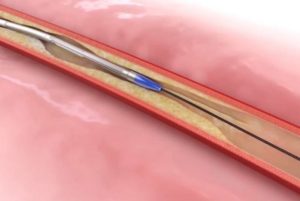
The Flex vessel preparation system (VentureMed group) is safe and effective, and appears to limit the potential risks of dissection and perforation of chronic total occlusions. This is the conclusion given by Constantino Peña (Miami Cardiac and Vascular Institute, Miami, USA) at the 2020 International Symposium on Endovascular Therapy (ISET; 22–25 January, Hollywood, USA) in his featured abstract presentation. Peña is a member of the scientific advisory board for Venture Medical.
“The Flex vessel preparation system effectively modified real-world plaque, including chronic total occlusions in the superficial femoral and popliteal arteries,” he said. “Furthermore, post-Flex subnominal inflation pressures demonstrate improved vessel compliance.” However, he added that “Further studies are warranted to confirm reduction in long-term re-intervention rates.”
In an initial, multicentre, retrospective review, investigators used the Flex vessel preparation system in 185 real-world cases: all lesions were long (over 20cm in length), and 69% had moderate to severe calcification. In 100% of lesions, there was some type of chronic total occlusion. Lesions were prepped just with the Flex system prior to either plain balloon angioplasty or treatment with drug-coated balloons (DCBs). The researchers collected angiograms at baseline, post-Flex, and post-procedurally.
Crucially, Peña said, there was a 34% mean luminal gain prior to treatment after the Flex vessel preparation system was used. Peña also reported sub-nominal inflation pressures averaged 4atm, and that there was a low rate (4%0 and grade (A or B) of dissections. He added that there were no flow-limiting dissections, perforations, or embolizations, and that provisional stenting “only occurred” in 28% of cases.
Illustrating these findings with some case examples, he talked the audience through the use of the Flex vessel preparation system in a 71-year-old man with Rutherford class 5 peripheral arterial disease (PAD). The pre-procedural stenosis rate of the target lesion was 100%. Following treatment with the Flex vessel preparation system, this dropped to 30%. There was also a 70% luminal gain post-Flex. After angioplasty, stenosis was 0%.
In the second case Peña recounted, vessel preparation with the Flex system prior to angioplasty reduced the stenosis rate from 100% to 50% in a 72-year-old woman with Rutherford class 3 PAD. There was a 50% luminal gain following use of the Flex system. Following angioplasty, the stenosis rate was 10%. These results are reported for a 41cm long lesion.
Vessel preparation aims to improve outcomes
Before discussing its importance, Peña first defined vessel preparation for the ISET attendees: “Its goal is the safe dilation of vessels to improve outcomes. This can be achieved through the modulation of a vessel in order to allow dilatation to its final diameter for definitive therapy or by modifying plaque to improve vessel compliance and reduce dissections. Vessel preparation can potentially improve diffusion of drug-coated balloon [DCB] therapy.”
Specifically referring to the Flex vessel preparation system, Peña described how it is able to “optimise the revascularisation of long, complex lesions with micro-incisions.” He highlighted multiple characteristics of the system that facilitate this.
“Firstly it is safe,” he said. “The Flex vessel preparation system creates predictable, depth-controlled micro-incisions that minimise the risk of dissection, perforation, and other complications.” Next, Peña informed delegates that the system is easy to use: “It has a simple design for treating long, complex lesions. It has a retrograde pull-back with minimal user variation, and no vessel sizing is needed.”
The Flex vessel preparation system is also cost-efficient, according to Peña. No capital equipment is required, as only one or two catheters are necessary to use Flex, which has a “quick, over-the-wire set-up”. The system has two working lengths–40cm and 120cm (in US and outside US markets, respectively). It has a reinforced braided shaft “for enhanced deliverability and torque performance”, and an atraumatic tip for “improved trackability and crossing profile”.
The Flex vessel preparation system is for use in the femoral and popliteal arteries, as well as for arteriovenous fistulas and grafts.










